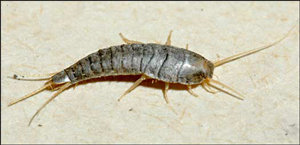Silverfish and Firebrats in Homes

Identification
A full-grown silverfish or firebrat is about a ¼-½ inch long. Both insects lack wings and have carrot-shaped bodies, thick at the front and tapering towards the posterior. The young look identical to the adults but are smaller. Silverfish and firebrats have two long antennae on their heads and three tail-like appendages on the tips of their abdomens. The five appendages are approximately as long as the body. Silverfish have uniformly colored silver bodies while firebrats have mottled gray-brown colored bodies. Both insects can move very fast when disturbed and homeowners often mistake them for cockroaches.
Biology
Silverfish and firebrats can be accidentally brought into buildings with boxes of materials that have been stored in infested areas. They can also move indoors from the outside. Once inside structures, they move quickly through buildings in search for food. When they find a source, they will generally stay close to it.
Silverfish and firebrats are general feeders, consuming a large variety of materials. They especially eat foods and products that are high in protein, sugar, or starch. This includes vegetable foods, such as flour and cereal; fabrics, including cotton, linen, silk, and rayon; sizing in paper; starch in clothing; and paste or glue. They also eat wallpaper, book bindings, and paper when trying to feed on the glue or paste underneath them. Their damage is usually recognized from their irregular feeding marks and the presence of feces. Silverfish and firebrats can go for months without feeding.
Both insects are active at night and hide during the day. They lay eggs in cracks, crevices, and other narrow, confined spaces. Silverfish prefer cool, moist, dark places with temperatures between 70o – 80° F and a relative humidity between 75% – 95%. They are often associated with basements, closets, bookcases, and storage areas. Firebrats also prefer damp areas but in places with temperatures over 90° F. They are found in boiler and furnace rooms, steam tunnels, insulation around hot water or heating pipes, bakeries, and similar places. Both silverfish and firebrats can also be associated with leaking or unventilated roofs and can be found on upper floors in buildings (if sufficient humidity exits (i.e. bathrooms).
Silverfish and firebrats run with characteristic, quick movements, stopping at short intervals and then moving on rapidly. These insects can not climb on smooth vertical surfaces and may be found trapped in sinks, bathtubs, and similar places. Despite the circumstantial evidence, they do not come up out of drains.
Importance
Jeffrey Hahn
Department of Entomology, University of Minnesota
Firebrat
Silverfish and firebrats are primarily nuisance insects, usually causing little damage. Although very uncommon, the potential exists for large, uncontrolled infestations of silverfish and firebrats to damage paper, book bindings, wallpaper, cereals, starched fabrics, leather, fur, silk and rayon. Silverfish and firebrats are not associated with the spread of any disease.
Management
When silverfish or firebrats are sighted or their damage is suspected, inspect basements, closets, storage areas, and other potential silverfish and firebrat sites to determine the source of the problem. Set out sticky traps to help determine where silverfish and firebrat numbers are the highest. Silverfish and firebrats can wander through buildings as they search for food and can be found away from food sources. Sometimes this source may be in inaccessible sites. Concentrate management efforts at the source of the infestations.
Nonchemical management
Tolerate small numbers of silverfish or firebrats when possible. You can capture a limited number of these insects by setting out sticky traps in areas where they have been sighted.
Silverfish and firebrats are associated with damp conditions. You can reduce their numbers by correcting moisture problems, e.g. drying out damp areas with a fan or dehumidifier, repairing leaky pipes, ventilating closed rooms, repairing leaking roofs, or sealing concrete walls and floors. If the problem occurs in a bathroom, make sure the ventilation fan is used during baths and showers. If you can not move materials, provide air spaces between boxes and other objects to promote air circulation. Keep in mind that as air cools the humidity in that air increases, so using a dehumidifier or gently heating the surrounding air can have a big impact on the infestation!
You can also reduce silverfish and firebrats by removing sources of food, especially in damp areas. You can reduce potential hiding places by removing old papers, books, boxes and other clutter. Seal cracks and crevices, including those found in baseboards, cupboards, and walls to limit harborages.
If the problem is associated with the roof, make sure that adequate ventilation is provided to avoid moisture accumulation. One particular problem that has been observed in the past was the installation of cedar shakes over a plywood / tarpaper base. Ventilation devices, such as soffit / ridge vents or roof vents must be installed to avoid moisture accumulation. Trees that overhang a roof may also add to the moisture build up and should be pruned back to promote air circulation.
Insecticidal management
Insecticides are normally not necessary for silverfish and firebrat management. However, if large numbers are discovered, it may be desirable to supplement nonchemical methods with an insecticide treatment to quickly reduce the infestation.
Some of the chemical options include:
You can apply boric acid, a type of inorganic dust. Common trade names include Roach Powder® and Roach Prufe®. Diatomaceous earth, also known as silicon dioxide, is also available. A representative trade name is Concern®. Follow the label and place the dust in cracks and crevices where silverfish and firebrats have been sighted. Do not apply dust where children and pets can reach it.
You can also make residual spot treatments along baseboards, cracks and crevices, and other areas where silverfish or firebrats are found. Insecticides, such as permethrin, deltamethrin, cyfluthrin, and cypermethrin are effective insecticides against these insects.
PLEASE CALL, 314-601-1789, US IF YOU HAVE SILVERFISH IN YOUR HOME. WE CAN TAKE CARE OF THEM FOR YOU.


